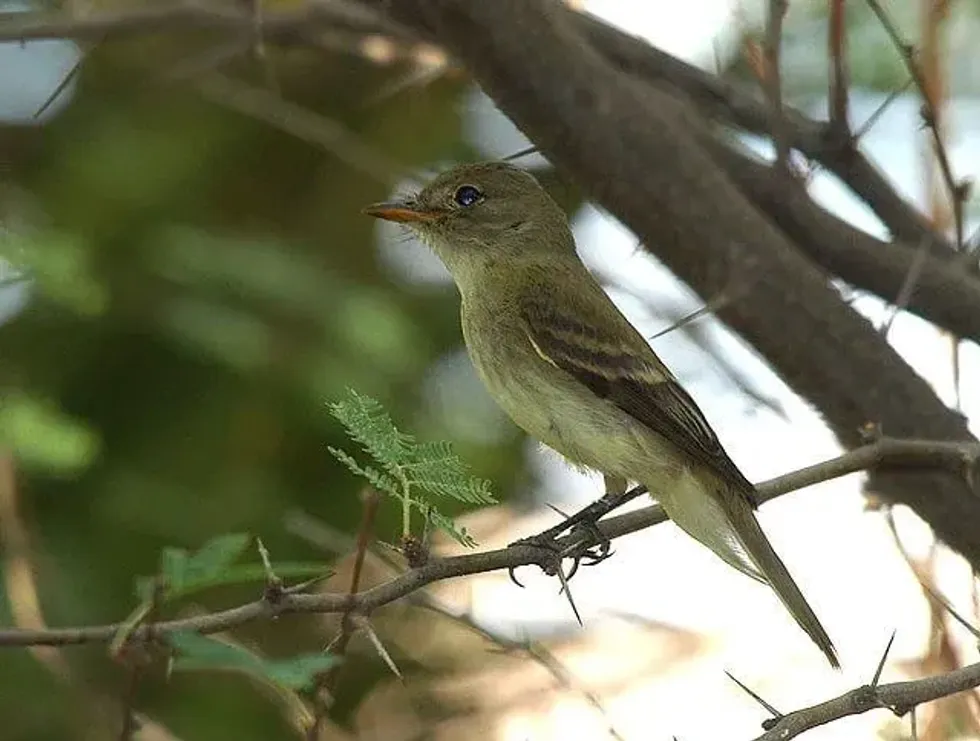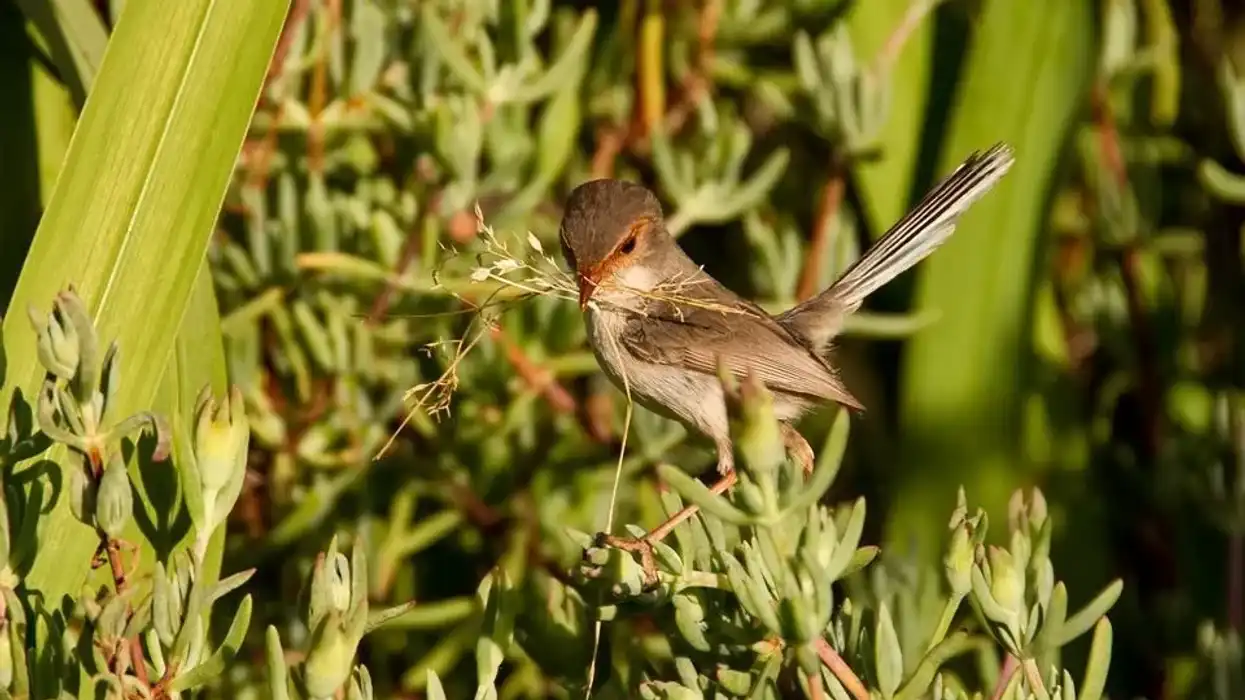The southwestern willow flycatcher (Empidonax traillii extimus) is one of the four subspecies of the willow flycatcher (Empidonax traillii) and a member of the family Tyrannidae.
Small and broad-billed with grayish-green wings, these birds are commonly found in dense vegetation, woodland areas, and shrubs near rivers and streams. The bird's breeding range is spread across Arizona, New Mexico, southern California, southwestern Colorado, the southern parts of Nevada and Utah, and western Texas, with wintering grounds in northern South America, Central America, and Mexico.
They have a distinct 'fitz-bew' song that helps to distinguish the subspecies from other songbirds and flycatcher species.
Unfortunately, populations of this flycatcher subspecies have been on a declining spree. Habitat loss and habitat fragmentation are the major threats to the members of the bird species. Consequently, the U.S. Fish and Wildlife Service identified the bird as an Endangered species in 1995 and designated its critical habitat in 2005.
Find these birds interesting? Then read on to know more about them!
If you like what you read, do check out other fascinating articles about the dusky flycatcher and spotted flycatcher.
Southwestern Willow Flycatcher Interesting Facts
What type of animal is a southwestern willow flycatcher?
The southwestern willow flycatcher (Empidonax traillii extimus) is a small-sized bird and one of the subspecies of the larger group of willow flycatchers.
What class of animal does a southwestern willow flycatcher belong to?
Southwestern willow flycatchers belong to the class Aves which includes all birds.
How many southwestern willow flycatchers are there in the world?
According to the American Bird Conservancy, the total population size of these birds is estimated to be around 2,500-3,000.
Where does a southwestern willow flycatcher live?
The native breeding ground of these flycatchers includes riparian areas or areas situated on the banks of a river. The riparian habitat may be a thicket, a scrubby and bushy area, a swamp, or woodland with dense vegetation.
What is a southwestern willow flycatcher's habitat?
The southwestern willow flycatcher's natural breeding ground and habitat range includes Arizona, New Mexico, southern California, southwestern Colorado, western Texas, and southern parts of Utah and Nevada. The birds winter in the rainforests of Central America, Central Mexico, and northern South America.
These bird prefers bushy and forested areas near water bodies such as a river or a stream. This species is mostly seen nesting in native vegetation such as willow, cottonwood, box-elder, water birch, alder, as well as introduced plant species like the Russian olive and tamarisk.
Who do southwestern willow flycatchers live with?
Not much is known as to whether this bird species lives solitary or in flocks. However, the males are known to be extremely territorial and defend their territory through aggression and counter singing. Territoriality is maintained on wintering grounds as well.
How long does a southwestern willow flycatcher live?
Willow flycatchers are known to have a lifespan of three to four years.
How do they reproduce?
Males arrive at the breeding grounds a week or two earlier than the females to set up territory. Once the females arrive, the males court the females by chasing them through the trees until a pair is established.
The female builds the breeding nest on the fork of a tree branch and supports it with several upward angling stems. Depending on the chosen tree, the height of the breeding nest can range between 3.3-39.4 ft (1-12 m).
Egg-laying begins in late May and continues into June and early July. On average, one breeding pair may produce a clutch of up to four eggs, with one egg being laid per day.
The eggs may be buff or tan in color with brown spots. The young birds hatch out after an incubation period of approximately 12 days. The nestling stage continues for another 12-15 days, during which both the parents take care of the young.
What is their conservation status?
The conservation status of the southwestern willow flycatcher has been listed as Endangered by the International Union for Conservation (IUCN) Red List of Threatened Species.
Southwestern Willow Flycatcher Fun Facts
What does the southwestern willow flycatcher look like?
This flycatcher subspecies is a small-sized bird with a gray-green to brownish olive upper body, a pale yellow abdomen, a pale olive breast, and a whitish throat. The two light-colored wing bars are conspicuous and the eye-ring is faint or almost absent, a stark distinction from other flycatcher species.
The beak is short with a pale yellowish lower mandible and a darker upper mandible. Males and females cannot be told apart from their plumage.
How cute are they?
The small and puffy appearance of this flycatcher subspecies makes them look extremely cute and adorable. They may not be as colorful as the vermilion flycatcher or the great crested flycatcher, but they are still quite eye-catching.
How do they communicate?
The characteristic loud and raspy 'fitz-bew' song of the southwestern willow flycatcher helps researchers to tell the bird apart from other species of willow flycatchers and songbirds. Apart from their typical call, these birds also give out 'brrrit' and 'whit' calls and will often do an upward flicking with their tails when perched.
Counter singing also appears to be a territory defending mechanism of the male birds.
How big is a southwestern willow flycatcher?
The southwestern willow flycatcher is about 5.75 in (14.6 cm) long. They are almost half the size of scissor-tailed flycatchers.
How fast can a southwestern willow flycatcher fly?
The exact flight speed of this willow flycatcher is not available.
How much does a southwestern willow flycatcher weigh?
The birds weigh in the range of 0.38-0.42 oz (10.7-12 g).
What are the male and female names of the species?
Male and female flycatchers do not have any distinct names.
What would you call a baby southwestern willow flycatcher?
A baby flycatcher would be called a nestling or fledgling.
What do they eat?
Much of the flycatcher's diet comprises insects such as shield bugs, hoppers, aphids, cicadas, true bugs, midges, gnats, mosquitoes, true flies, sawflies, wasps, bees, ants, and dragonflies.
Are they dangerous?
No, flycatchers are not dangerous to humans. However, these birds get quite aggressive towards each other while defending territories.
Would they make a good pet?
Since the southwestern willow flycatcher is protected by federal laws, it cannot be kept as a pet. Besides, replicating its natural riparian habitat would be a challenge in domestic environments.
Did you know...
The breeding nest of the flycatcher is built with grasses, cattail tufts, and shredded bark.
Besides the U.S. Fish and Wildlife Service notifying this flycatcher as Endangered, the California Endangered Species Act also lists this bird as endangered since 1990. The bird is also listed as endangered in the Endangered Species Act of 1995.
In 2013, the U.S. Fish and Wildlife Service designated critical habitat areas of this willow flycatcher subspecies in the Los Padres National Forest (California, USA). Designating it as a critical habitat greatly helps to reduce activities that damage the bird's population.
Why is the southwestern willow flycatcher endangered?
Major threats that have put populations of this willow flycatcher subspecies into jeopardy include livestock grazing, fires, water projects such as dams, reservoirs, and groundwater pumping, agriculture development, channelization, bank stabilization, and the replacement of native vegetation through the introduction of invasive species of exotic plants.
Brown-headed cowbird parasitism has also led to a rapid decline in the number of flycatchers.
Brown-headed cowbird parasitism is a phenomenon whereby the cowbird removes one or more eggs from the nest of other bird species and replaces them with its own.
The cowbird's eggs hatch sooner, and the young grow faster, outnumbering and starving hatchlings of the nesting bird. Hence, the nesting success of the flycatchers is greatly reduced.
How does the Southwestern willow flycatcher contribute to the health of the forests?
To a large extent, the health of riparian ecosystems depends on insectivorous birds. According to studies, insect predation by the flycatchers results in improved health of the riparian trees and forests.
The southwestern willow flycatcher and other insectivorous birds of the riparian habitats consume large amounts of insects, including mosquitoes. By keeping control of insect populations, the flycatchers not only keep humans comfortable but also maintain the health of the forests.
Here at Kidadl, we have carefully created lots of interesting family-friendly animal facts for everyone to discover! For more relatable content, check out these yellow-headed caracara facts and black caracara facts for kids.
You can even occupy yourself at home by coloring in one of our free printable flycatcher coloring pages.










